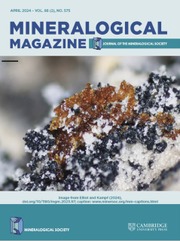No CrossRef data available.
Article contents
The epidote–törnebohmite polysomatic series: structural relationships and complexity
Published online by Cambridge University Press: 04 August 2025
Abstract
The ETn homologous row of the epidote–törnebohmite polysomatic series is considered, which includes minerals of the epidote (n = 0) and gatelite (n = 1) supergroups and radekškodaite group (n = 2). The crystal structures of members of the series are based upon the alternation of epidote (E) and törnebohmite (T) two-dimensional modules. The aristotype structure types of the members of the row crystallise in the P21/m space group with the unit-cell parameters a ≈ 8.90, b ≈ 5.65, c ≈ (10.10 + 7.50n) Å, β ≈ 116.5° and V ≈ (455 + 338n) Å3. The general formula for the members of the row can be expressed as A2(n+1)Mn+3[Si2O7][SiO4]2n+1Xn+2 (X = O, OH and F). The structure model for the hypothetical ET3 member of the series is constructed and the general formulae are derived for the calculation of the number of atoms per unit cell and the number and multiplicities of the atom sites for any value of n. The concept of K-sequence is introduced that is analogous to the concept of a Wyckoff sequence. The general formulae for the information-based complexity parameters are derived for the ETn homologous row of the epidote–törnebohmite polysomatic series with different parities of n. The present absence of the members of the series with n > 2 reflects the entropic restrictions on the polysomatic series that confirm the principle of maximal simplicity for modular inorganic structures.
Keywords
Information
- Type
- Article
- Information
- Copyright
- © The Author(s), 2025. Published by Cambridge University Press on behalf of The Mineralogical Society of the United Kingdom and Ireland.
Footnotes
Guest Editor: Robert F. Martin
This paper is part of a collection in tribute to the work of Edward Grew at 80

